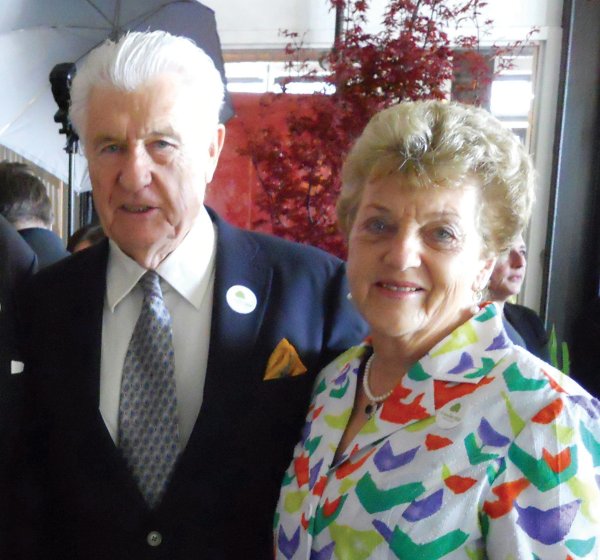
Most Leasiders are probably unaware of one of the most striking parts of St. Anselm’s Church, on Millwood at Bessborough, which has many striking parts.
It’s hard to notice the steeple, even though it’s four feet higher than the church itself, which is 50 feet high. The cross on top of the steeple is 12 feet high, which makes it the highest point in the area.
But it and the almost tortured history of the steeple are little known to non-parishoners. Many Leasiders know that two recent storms this year caused cladding to fly off the base of the steeple, but its history is much more interesting.
In 1963 the parish’s second priest, Father Merrit Griffin, was tasked with building a new church to replace the smaller one that opened in 1942.
Joan Sparrey, of Leacrest Rd., remembers the first church: “It was built of cinder blocks so my childhood memory is that it smelled musty and old.” Capacity was only 400 people and she recalls that “the sanctuary was always full to overflowing and we had to use the basement too”.
“Father Griffin wanted to build one of the finest churches in Canada – and he did!” said Leasider Michael Pieri, of MacNaughton Rd., in a 1988 history of the parish. But it wasn’t simple, and still isn’t.
“The steeple had to be built inside the church and then hoisted up by crane and fastened into place just before the roof was closed in,” explains retired engineer Jan Melchers, of Annesley Ave. in North Leaside.
As with any building, problems arose. When Father Brian Clough, who served as parish priest 2003-2014, noticed the roof was leaking in 2008 he set up a building committee, asked Melchers to chair it and advised the parish that a fundraising campaign was needed.
Eventually the renovations expanded to include not just repairing the roof, but also removing asbestos, adding insulation, replacing wiring, re-leading the windows, installing accessible washrooms and adding a new high-efficiency boiler.
“100 percent of the funds needed were raised by the parishioners,” says Father Clough, who now serves in Mississauga. “The parish pulled together and raised $1.3 million over five years – they made it happen. And Jan Melchers oversaw the whole project.”
Melchers says, “For five and a half years I was there almost every day – contractors need oversight.” The renovations were completed in 2014.
Which brings us back to the steeple.
“It’s in the shape of a plus sign,” explains Melchers. “The southeast and southwest faces are exposed to the sun, and the southwest gets the wind. On March 4 two panels of the copper cladding blew off the base of the steeple on the southwest side. Temporary repairs were made but then on Easter Monday [March 28] 11 more panels blew off in the high winds.”
Contractors were brought in to provide a temporary fix with stainless steel bolts, but a permanent solution will be expensive.
“The whole steeple will have to come down, be rebuilt on the ground and then lifted back up. The scaffolding has to be completely safe. And the repairs have to be done right, with copper cladding again – which lasts longer but is more expensive – if they’re going to be done at all.
“We are waiting on cost estimates from the contractors,” Melchers says, “but the decision on whether to repair and rebuild or not is dependent on how the congregation feels about it. If they ask me, I would not think it was worth it. Personally, I don’t think much of the steeple. Some people might not even know we have a steeple – you can’t see it from Millwood Rd., especially when the trees are in leaf in the summer.”
The early 1960s, when the current church was being built, was a time of great change in the Catholic Church. The Second Vatican Council was underway in Rome and, although it would not complete its work until the end of 1965, Father Griffin made important design decisions with reform very much in mind.
The railing separating the priest and congregants was done away with and the altar was placed so that the priest would face the people when preparing the elements for mass rather than have his back to them.
The trusses were made of Douglas Fir from British Columbia; the stone for the walls came from Kingston, the marble and terrazzo flooring from Italy. The altar, candlesticks, statuary and other works of art were commissioned from around the world and, seemingly, no expense was spared.
One of the new church’s most spectacular features – the massive stained glass window over the Millwood Rd. entrance, which includes elements depicting all the major religions and racial groupings of humanity – embodies the ecumenical spirit that would be a hallmark of Vatican II.
Sparrey serves as a eucharistic minister at St. Anselm’s and helps distribute communion, something that would never have been possible before Vatican II.
“The Catholic Church is often perceived as thinking it is somehow better or different than other faiths,” she says, “but, every time I stand at the altar and look out, that window says to me that we’re all embracing a common faith and we’re all accountable. I find it very moving.”
Meanwhile, church parishioners have other things on their minds too, including the steeple.
On June 14 they bade a final fare-well to Monsignor Edward Boehler who, in addition to many other roles in the Archdiocese, served as pastor at St. Anselm’s [see Page 12]. On June 26, in addition to celebrating the 50th anniversary of the building, they said good-bye to Monsignor Marco Laurencic, who served as pastor for the past two years. And in July, Father Jozef Vano will arrive as pastor and lead St. Anselm’s into its next chapter.





